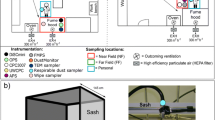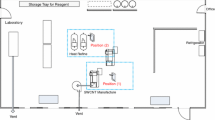Abstract
Size distributions of nanoparticles in the vicinity of synthesis reactors will provide guidelines for safe operation and protection of workers. Nanoparticle concentrations and size distributions were measured in a research academic laboratory environment with two different types of gas-phase synthesis reactors under a variety of operating conditions. The variation of total particle number concentration and size distribution at different distances from the reactor, off-design state of the fume hood, powder handling during recovery, and maintenance of reactors are established. Significant increases in number concentration were observed at all the locations during off-design conditions (i.e., failure of the exhaust system). Clearance of nanoparticles from the work environment was longer under off-design conditions (20 min) compared to that under normal hood operating conditions (4–6 min). While lower particle number concentrations are observed during operation of furnace aerosol reactors in comparison to flame aerosol reactors, the handling, processing, and maintenance operations result in elevated concentrations in the work area.







Similar content being viewed by others
References
Basak S, Chen DR, Biswas P (2007) Electrospray of ionic precursor solutions to synthesize iron oxide nanoparticles: modified scaling law. Chem Eng Sci 62(4):1263–1268
Biswas P, Wu CY (2005) Critical review: nanoparticles and the environment. J Air Waste Manag Assoc 55(6):708–746
Clarence DJ (2008) Managing the effects of nanotechnology. Project on Emerging Nanotechnologies, Washington, DC
Demou E, Peter P, Hellweg, S (2008) Exposure to manufactured nanostructured particles in an industrial pilot plant. Ann Occup Hyg. doi:10.1093/annhyg/men058
DOE (2007) Approach to nanomaterial ES&H. NSRC Revision 2. Department of Energy Nanoscale Science Research Centers
Iyiegbuniwe EA, Iyiegbuniwe AO, Chekuri L (2007) Nanomaterials and health: a critical review of occupational exposure assessment and control strategies. Int J Nanomanuf 1(5):574–591
Jiang J, Chen DR, Biswas P (2007) Synthesis of nanoparticles in a flame aerosol reactor with independent and strict control of their size, crystal phase and morphology. Nanotechnology 18:285603
Jiang J, Oberdorster G, Elder A, Gelein R, Mercer P, Biswas P (2008) Does nanoparticle activity depend upon size and crystal phase? Nanotoxicology 2(1):33–42
Lee MH, McClellan WJ, Candela J, Andrews D, Biswas P (2007) Reduction of nanoparticle exposure to welding aerosols by modification of the ventilation system in a workplace. J Nanopart Res 9(1):127–136
Limbach LK, Wick P, Manser P, Grass RN, Bruinink A, Stark WJ (2007) Exposure of engineered nanoparticles to human lung epithelial cells: influence of chemical composition and catalytic activity on oxidative stress. Environ Sci Technol 41(11):4158–4163
Maynard AD, Kuempel ED (2005) Airborne nanostructured particles and occupational health. J Nanopart Res 7(6):587–614
Maynard AD, Baron PA, Foley M, Shvedova AA, Kisin ER, Castranova V (2004) Exposure to carbon nanotube material: aerosol release during the handling of unrefined single-walled carbon nanotube material. J Toxicol Environ Health A 67(1):87–107
Namiki N, Cho K, Fraundorf P, Biswas P (2005) Tubular reactor synthesis of doped nanostructured titanium dioxide and its enhanced activation by coronas and soft X-rays. Ind Eng Chem Res 44(14):5213–5220
Nel A, Xia T, Madler L, Li N (2006) Toxic potential of materials at the nanolevel. Science 311(5761):622–627
NIOSH (2002) Exposure assessment methods: research needs and priorities. NIOSH report
NIOSH (2007) Progress towards safe nanotechnology in the work place. A report from NIOSH nanotechnology Research Center
Oberdorster G, Ferin J, Lehnert BE (1994) Correlation between particle-size, in vivo particle persistence, and lung injury. Environ Health Perspect 102:173–179
Oberdorster G, Oberdorster E, Jon JG (2005) Nanotoxicology: an emerging discipline evolving from studies of ultrafine particles. Environ Health Perspect 113(7):823–839
Park J, Kwak BK, Bae E, Lee J, Kim Y, Choi K, Yi J (2009) Characterization of exposure to silver nanoparticles in a manufacturing facility. J Nanopart Res. doi:10.1007/s11051-009-9725-8
Sayes CM, Reed KL, Warheit DB (2007) Assessing toxicity of fine and nanoparticles: comparing in vitro measurements to in vivo pulmonary toxicity profiles. Toxicol Sci 97(1):163–180
Thimsen E, Biswas P (2007) Nanostructured photoactive films synthesized by a flame aerosol reactor. AIChe 53(7):1727–1735
Tsai S, Ashter A, Ada E, Mead JL, Barry CF, Ellenbecker MJ (2008) Airborne nanoparticle release associated with the compounding of nanocomposite nanoalumina as fillers. Aerosol Air Qual Res 8(2):160–177
Tsai SJ, Ada E, Isaacs JA, Ellenbecker MJ (2009) Airborne nanoparticle exposures associated with the manual handling of nanoalumina and nanosilver in fume hoods. J Nanopart Res 11(1):147–161
Vincent JH, Clement CF (2000) Ultrafine particles in workplace atmospheres. Philos Trans R Soc Lond Ser A 358(1775):2673–2682
Acknowledgments
This study was partially supported by a grant from the U.S. Department of Defense (AFOSR) 20 MURI Grant, FA9550-04-1-0430. Manoranjan Sahu thanks the McDonnell International Scholars Academy and the McDonnell Academy Global Energy and Environment Partnership (http://www.mageep.wustl.edu) for providing partial support.
Author information
Authors and Affiliations
Corresponding author
Rights and permissions
About this article
Cite this article
Sahu, M., Biswas, P. Size distributions of aerosols in an indoor environment with engineered nanoparticle synthesis reactors operating under different scenarios. J Nanopart Res 12, 1055–1064 (2010). https://doi.org/10.1007/s11051-010-9874-9
Received:
Accepted:
Published:
Issue Date:
DOI: https://doi.org/10.1007/s11051-010-9874-9




